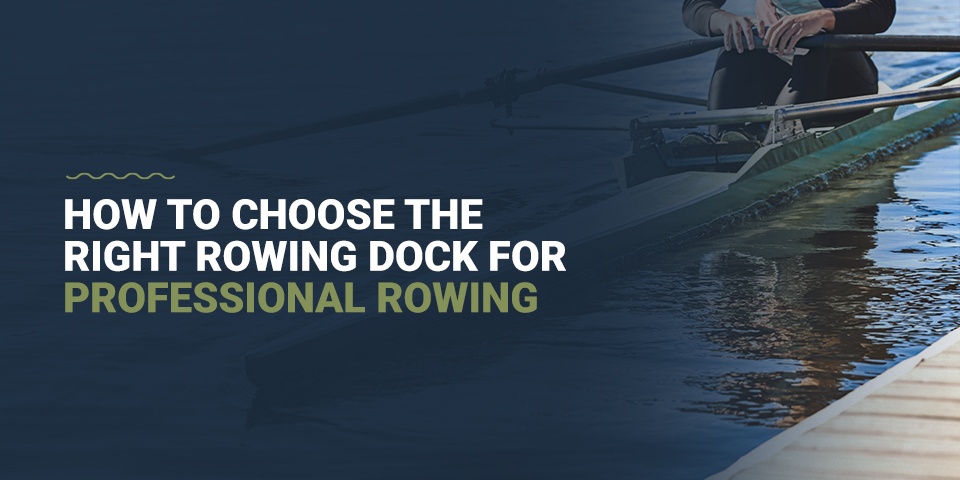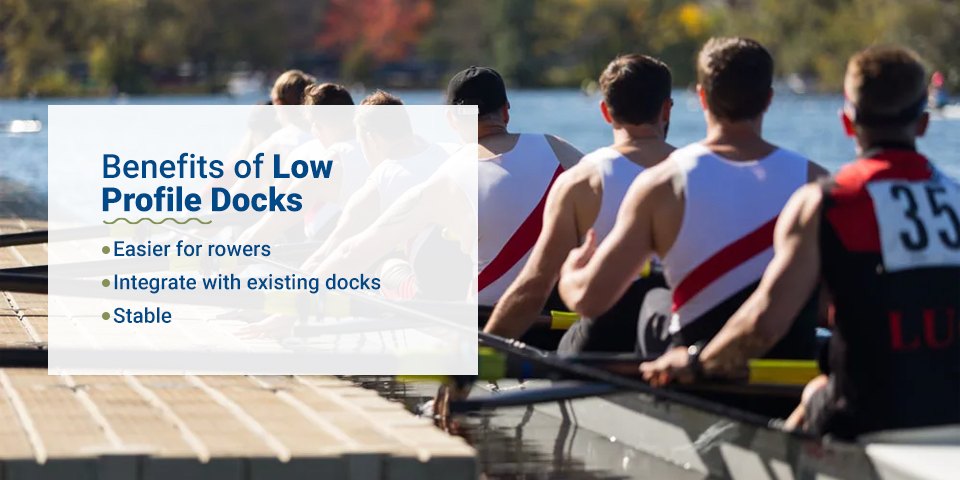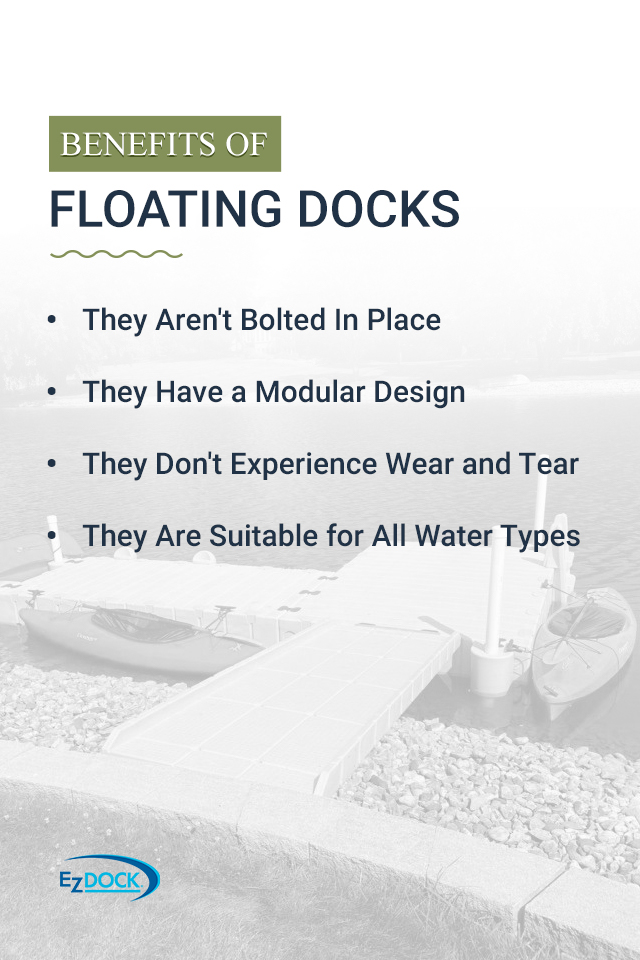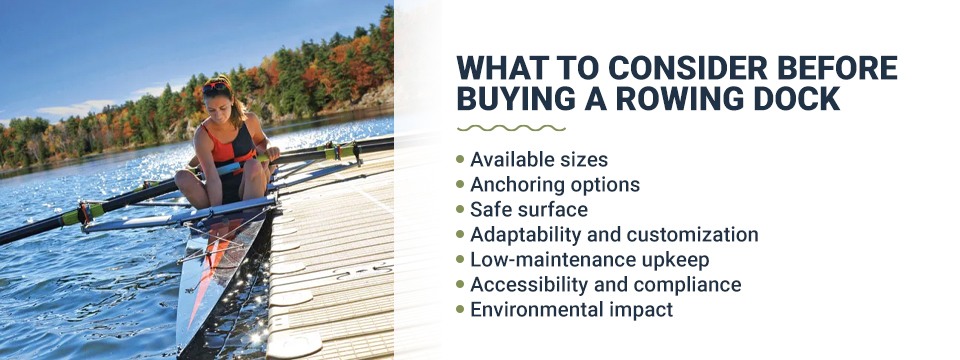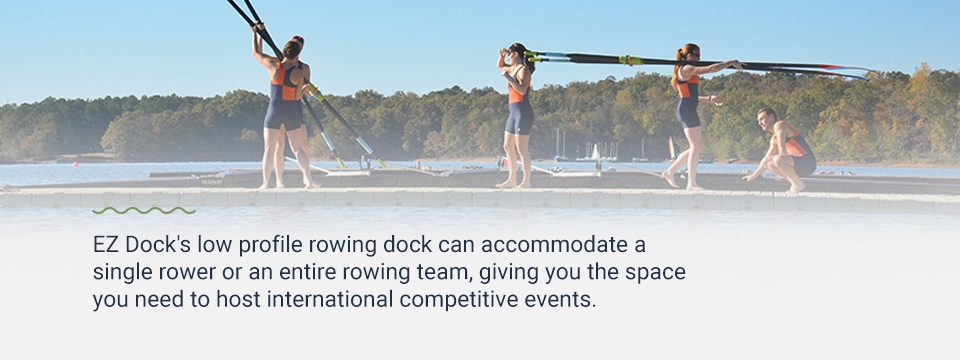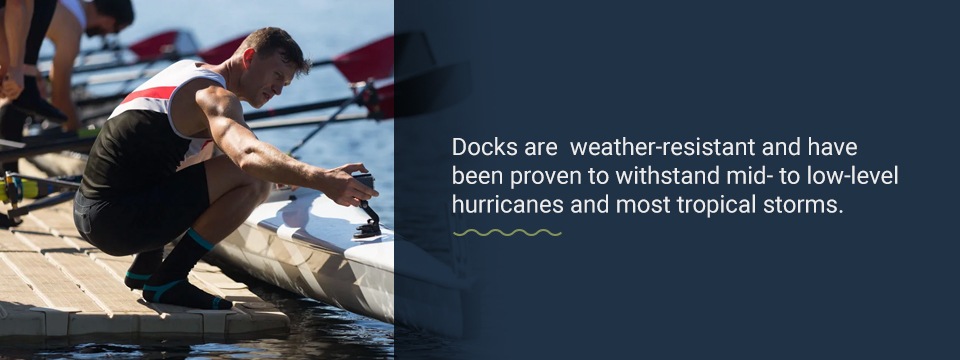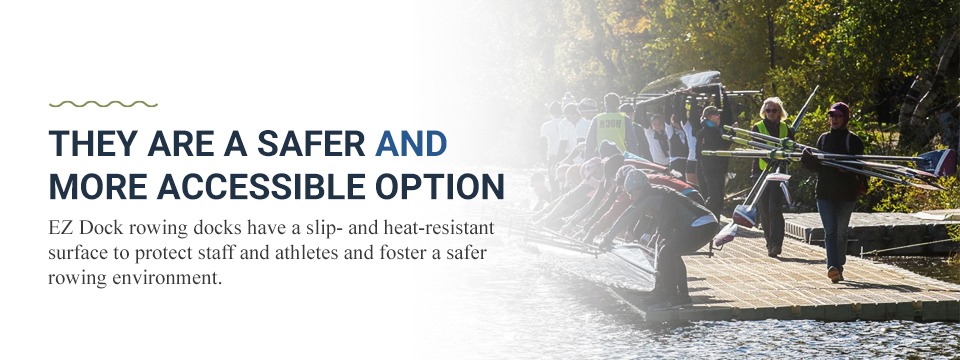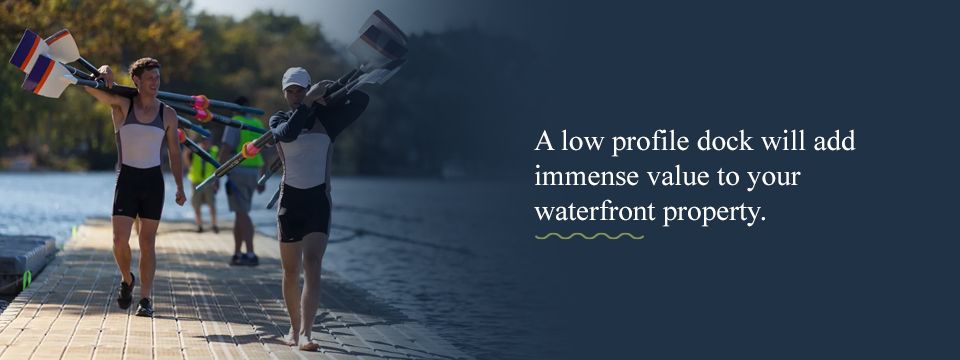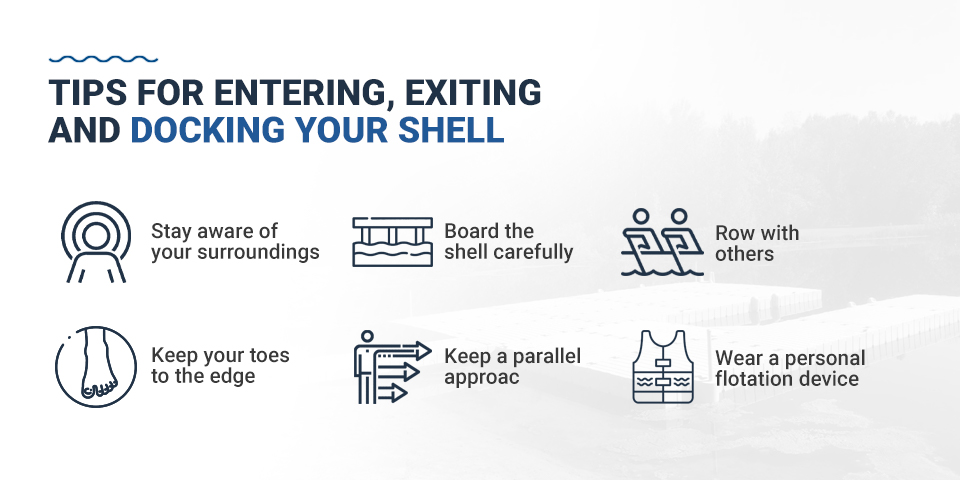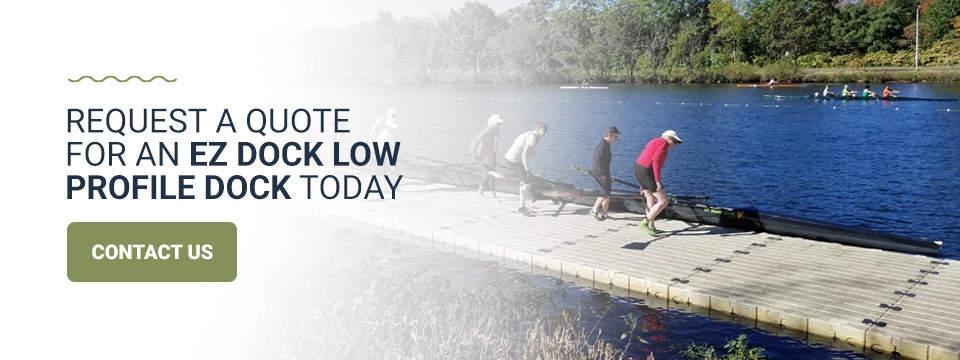Filters
How to Choose the Right Rowing Dock for Professional Rowing
Though rowing has always been a popular sport in the United States, its popularity continues to gain traction. As of 2018, USRowing — the U.S. national governing body for rowing — reported more than 75,000 total members, an increase from prior years. Nearly 22% of U.S. rowing organizations are at the collegiate level.
Whether you’re rowing alone or with a crew, the sport calls for special docking considerations to prioritize safety and comfort. The 2020 professional rowing rules assert that all professional rowing events acquire sufficient docks that support both launch and recovery — but what kind of dock does that mean? When comparing rowing docks vs. traditional docks, rowing docks are usually low profile. Low profile docks are designed with professional rowers in mind, making it easier than ever to board, launch and return during events. Learn more about this special docking option and what sets them apart from the alternatives.
Read the full article or jump to a specific section:
- What are Low Profile Docks?
- Benefits of Floating Docks
- What to Consider Before Buying a Rowing Dock
- Benefits of Using an EZ Dock Low Profile Dock
- Tips for Entering, Exiting and Docking Your Shell
- Establishing Safety Guidelines for Your Rowing Dock
What Are Low Profile Docks?
The best option for a professional rowing team is a low profile dock. Compared to traditionally sized docks, low profile dock sections sit lower to the water and have a shorter freeboard height. Freeboard height refers to the space between the dock’s surface and the water’s surface.
Some benefits of low profile docks are:
- They are easier for rowers: Rowing requires great physical strength and stamina — the more power and energy the rower preserves before and after a match, the better. The low profile dock’s lower freeboard height means that it’s easier for rowers to board, launch and return to the dock without using too much energy on lifting themselves in and out of the vessel.
- They integrate with existing docks: You don’t have to secure the property and resources to build a section of docking specifically for rowers — low profile docks come in modular sections or pre-made configurations, so you can integrate them with your existing dock structure. Because they are available in sections, you can choose as many low profile platforms as you need to create your desired dock length.
- They are stable: Low profile docks can be just as sturdy and secure as traditional docks when you pair them with an anchoring system and couplers. The anchoring system holds the dock sections into place, connecting them to another dock, gangway, shoreline or beneath the water. Couplers connect individual docking sections to ensure a secure and seamless experience while simultaneously absorbing impact-related shock and movement. Anchoring systems and dock couplers support various weights and capacities.
Benefits of Floating Docks
EZ Dock crafts low profile docks to help rowers achieve better accessibility and speed while minimizing stress and strain on the body.
One of the most significant advantages of EZ Dock low profile rowing docks over traditional docks is that they float. EZ Dock floating docks are low-density polyethylene (LDPE) and have specially designed air chambers that let them float on the water’s surface instead of being permanently fixed in place below the water.
Floating docks have numerous benefits over traditional docking systems.
They Aren’t Bolted In Place
Stationary docks are bolted into the shoreline or gangway. They often use complex fasteners and underwater mechanisms. This makes it impossible to relocate, change or extend your dock once it’s assembled. Floating docks do not require bolts to stay secure. While you can still pair them with gangways and ramps to bridge the gap between your dock and land, it’s not always needed.
That doesn’t mean floating docks aren’t stable — they fall and rise with the water but involve minimal movement. You can pair a floating dock with accessories like handrails and anchoring systems — which are optional and removable — to create an even sturdier dock. Because floating docks are removable, you can also disassemble and store them each winter, something many communities require.
They Have a Modular Design
Modular floating docks are available in individual sections or pre-made configurations to suit your property and budget. This modular design means you don’t have to make any permanent layout decisions, and you can easily disassemble your low profile rowing dock and reassemble it at multiple different events throughout the year.
You can also easily pair modular docks with accessories, like personal watercraft ports, kayak or canoe launches, gangways, railings and swim platforms to create a multi-use space.
They Don’t Experience Wear and Tear
Because floating docks move with the water, you no longer have to worry about damage and deterioration from the environment, such as:
- Rusted or corroded hardware and fasteners.
- Worn, splintered or warped decking boards.
- Loose and unstable docking surfaces.
- Structural collapse due to weakened construction.
- UV-fading and blistering.
- Impact-related damage caused from launching and docking vessels.
They Are Suitable for All Water Types
You’ll find rowing docks across the residential and commercial sectors, where they enhance the lives of hobbyists and professional rowers alike. They are suitable for all types of industries and property types, including freshwater and saltwater lakes, oceans, rivers and ponds, regardless of water conditions. With traditional docks, boarding and launching your shell is challenging if the water level is too low or high, and many are only suitable for one kind of water. Floating docks adjust with natural changes, letting you enter and exit at the same level as the water.
What to Consider Before Buying a Rowing Dock
Successful professional rowing begins before you hit the water, which is why many teams have rules and expectations to follow when at the docks, like specific commands or noise restrictions. The dock is a critical part of the sport — it’s where teams load their shells in and out of the water, board, launch and collect themselves before and after competing.
Consider these factors when buying a rowing dock for your rowing team or property:
- Available sizes: According to the USRowing Rules of Rowing, launching docks for professional rowing competitions should be able to accommodate at least three eights at the same time for competing crews. The Dockmaster and control commission structure with a table and chairs should also be easily accessible from the dock’s launching area. Your rowing dock should be large enough to meet these requirements, preferably with a modular design that lets you add and remove sections as events demand it.
- Anchoring options: Though not always required, anchoring is the best way to ensure your dock remains stable and strong, even during severe weather. Consider what anchoring options are available for a rowing dock before installing it on your property and whether those options are compatible with your existing setup.
- Safe surface: USRowing lists the dock as one common site for rowing-related accidents. Minimize this risk by choosing a material that does not splinter or weaken. Look for docks made from a material like polyethylene, which is slip-resistant to reduce the chance of falls and won’t absorb the heat, preventing burns on bare feet and hands.
- Adaptability and customization: You want a rowing dock with multiple configuration options that you can adapt to your property, including any necessary gangways, ramps and non-rowing dock sections.
- Low-maintenance upkeep: You need a dock that looks great and performs even better, but dock upkeep can eat away at your time and budget. That’s why low-maintenance rowing docks are ideal. Polyethylene floating docks come clean after heavy rains, and you can make them shine like new with a pressure washer or quick scrub with soap and water. They require no chemical treatments, seasonal repainting or ongoing servicing. They are a long-lasting solution that is weather resilient and easy to store.
- Accessibility and compliance: If your competitive event or regatta requires you to provide a dock that meets the accessible routes guidelines of section 402 of the Americans with Disabilities Act (ADA), you can work with a docking company to help you achieve ADA accessibility.
- Environmental impact: Clean, safe water is critical for the enjoyment and longevity of professional rowing. Your docking system should have a minimal environmental impact on the water and its ecosystems. This means avoiding docks requiring chemical treatments or extensive shoreline excavation.
Benefits of Using an EZ Dock Low Profile Dock
EZ Dock is an official premier sponsor for the Head of the Charles Regatta and has helped launch thousands of professional shells for crews everywhere. EZ Dock low profile rowing docks are 8 inches tall, with an unloaded freeboard height of 5.5 inches, perfect for safe shell entry and exit. Its patented design meets and exceeds all FISA and USRowing standards.
The following advantages make the EZ Dock low profile dock the ideal match for your rowing team.
EZ Dock Systems Can Support One Rower or the Entire Team
The EZ Dock low profile rowing dock can accommodate a single rower or an entire rowing team, giving you the space you need to host international competitive events. The live load capacity can support multiple launches on both sides, with an adaptable modular design that lets you make changes as needed.
In addition to standard rectangular pieces, EZ Dock floating dock sections come in several pre-designed shapes, which you can connect or use as an individual unit:
- U-shape
- T-shape
- L-shape
- I-shape
- F-shape
Floating dock sections can also integrate into your existing dock, even if it’s a traditional permanent fixture and not a floating dock design. The air chambers will create a consistently stable walking environment, while the coupler system will keep sections securely connected to your other dock structure. If you need to make a design change or take your dock to a different property for an event, you can disassemble each section as the situation arises. When it’s time for winter storage or relocation, you can add wheels to make transportation even easier.
They Are a Reliable Long-term Investment
Your rowing dock is an investment that will serve your team for years to come. EZ Dock low profile docks are a long-lasting solution. They are easy for staff to install on their own, or you can contact a representative to come to visit your property for quick, stress-free installation.
EZ Dock has several anchoring options available, including hoops and brackets, piping and winch inserts, to keep your floating rowing dock even more stable in all conditions. All coupling systems have strong, rust-resistant fasteners for a secure hold. Docks are also weather-resistant and have been proven to withstand mid- to low-level hurricanes and most tropical storms.
EZ Dock Is an Eco-Friendly Solution
EZ Dock works with environmental specialists and conservation experts to create innovative, eco-safe products. Unlike treated wood docks, polyethylene docks contain no harmful contaminants that could endanger water and wildlife. Their unique air chamber design sets them apart from other floating docks, which often house dangerous foam that threatens ecosystems. We design all EZ Dock coupling systems from 90% pre- and post-consumer recycled waste.
If you’re limiting your environmental impact to maintain local compliance, take advantage of green initiatives or preserve your property’s natural beauty, an EZ Dock rowing dock is the solution you’re looking for.
They Are a Safer and More Accessible Option
EZ Dock rowing docks have a slip- and heat-resistant surface to protect staff and athletes and foster a safer rowing environment. Our products also meet the guidelines for the United States Access Board’s universal accessibility regulations. Our team will work one-on-one with your team committee to help your new rowing dock configuration meet and maintain necessary standards.
They Add Value to Your Property
A low profile dock will add immense value to your waterfront property. While we designed our rowing dock to meet professional rowing teams’ needs, it’s also versatile and adaptable. Athletes and visitors alike can use your low profile dock for other water-based recreation, such as swimming, boating, fishing and lounging.
If your rowing team is at the collegiate level, much of your success relies on attracting potential students by offering premier amenities and options for student engagement, team sports and learning opportunities. When you pair a rowing dock with standard-size floating dock sections, you can create a waterfront retreat ideal for studying, outdoor classroom events and extra-curricular activities.
Consider implementing these additional EZ Dock products to enhance your waterfront space:
- A polyethylene bench with armrests and cup holders that attaches directly to your dock, perfect for students and visitors who want to enjoy the view.
- A one-piece slip-resistant swim ladder to help swimmers get in and out of the water quickly and safely.
- Stylish security curbing to create a visually appealing color contrast while creating a safer dock for people who use wheelchairs.
- An attachable storage corner box so the grounds maintenance staff can keep important docking supplies easily accessible.
- An EZ BoatPort for easy drive-on, drive-off boat docking.
- An EZ Launch system to help kayakers and canoers enter, exit and launch their vessels.
- An EZ Trail walkway system, so you can create an on-the-water walking path around your pond or lake’s perimeter.
All of these items are compatible with other EZ Dock floating dock sections, including our low profile rowing dock.
Tips for Entering, Exiting and Docking Your Shell
Rowing shells can be challenging to handle due to length and weight. Make it easier with these tips:
- Stay aware of your surroundings: Stay alert and aware of your surroundings when launching, boarding and docking your shell. Watch for wildlife and other boaters to avoid a collision.
- Keep your toes to the edge: A critical part of shell launching is “toeing the edge,” when rowers place their feet beyond the edge of the dock while lowering the shell into the water to keep it from scraping. Though your low profile dock is unlikely to sustain any damage, you don’t want to risk shell damage before an important event.
- Board the shell carefully: Never board a shell unless you’ve been trained to do so. You should lower yourself in slowly, one leg at a time, keeping a squatting position and letting the handles and dock support your weight when possible. Always check that oars are secured inside the oarlock before boarding and exiting.
- Keep a parallel approach: When it’s time to dock your boat, approach the rowing dock from a parallel angle to avoid a collision. If wind and currents are too strong, let them guide you toward the dock, rather than fighting against them. Change your approaching angle as needed to find the right position.
- Row with others: Rowing is easier to do with others, especially when it comes to launching and docking. Do not attempt to launch a large shell without enough people to direct and control it safely.
- Wear a personal flotation device: Wear an approved personal flotation device (PFD) when necessary, including team practices and leisurely rowing. Your PFD should fit your body without being too tight or too loose and should not impede your movement or visibility.
Establishing Safety Guidelines for Your Rowing Dock
Your lake or pond is a valuable part of your property. It’s a natural focal point and gathering spot and helps tell the story of what sets your facility apart from the rest. All docks should have a clearly displayed sign listing all safety rules, restrictions and guidelines to keep everyone safe while they enjoy your facilities.
Examples of safety guidelines you might want to enact are:
- Visitors should not run or play on docks or rowing platforms.
- Prohibit littering or disposing of trash, liquids, food, tobacco products, chemicals or other potentially hazardous waste in or near the water.
- Discourage or prohibit the use of alcohol or mind-altering substances while on the water and docks.
- Limit after-dark dock use to prevent accidents.
- Visitors should wear a PFD while using the docks, especially if it’s located over deep water.
- Docks should remain free of obstructions that threaten visitor safety or render the dock inaccessible for other users.
- All vessels should be secured at the dock when not in use, and no vessel should be left unattended unless given prior approval.
Illuminate your dock rule signs with uplighting for after-dark visibility and include a printed list of restrictions in your organization’s handbook.
Request a Quote for an EZ Dock Low Profile Dock Today
Set your rowing team up for success with a low profile rowing dock from EZ Dock. Our rowing docks are convenient and easy to use, so your team can focus their energy and attention on the competition. Find an EZ Dock distributor near you to learn more about our floating dock systems and accessories, or request an online quote to take the next step toward creating a more attractive and efficient property. Our representatives are also available to answer your docking questions or help you find the best products for your institution’s needs.

